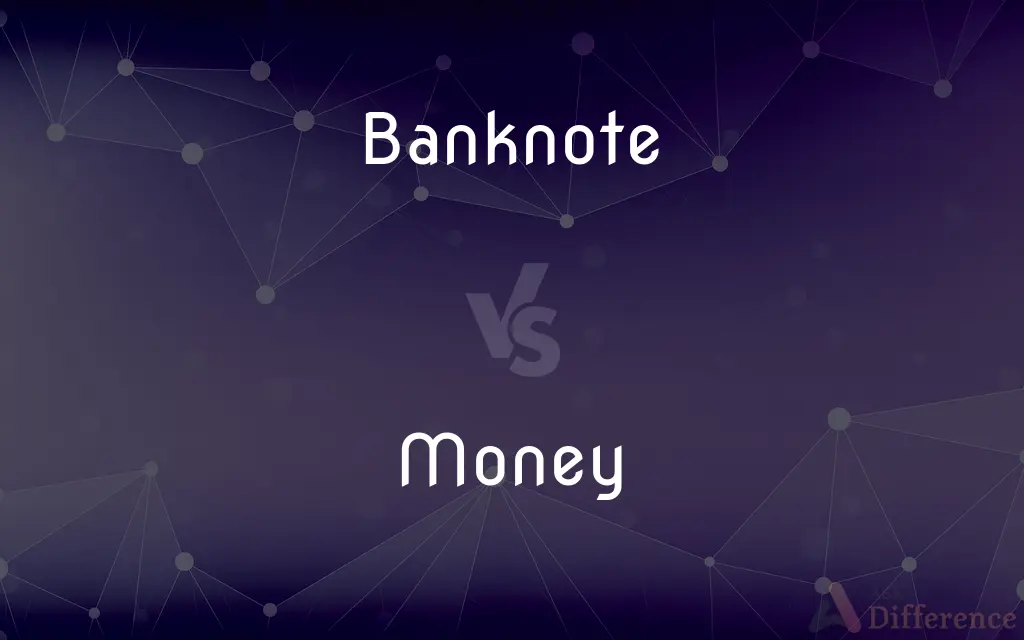Banknote vs. Money — What's the Difference?
By Fiza Rafique & Urooj Arif — Updated on May 3, 2024
A banknote is a type of money in the form of a paper note issued by a bank or a central authority, whereas money encompasses various forms including banknotes, coins, and digital currency used for purchasing goods and services.

Difference Between Banknote and Money
Table of Contents
ADVERTISEMENT
Key Differences
Banknotes represent one specific form of money, typically issued by a nation's central bank or government. They are legal tender in paper form, used for everyday transactions. In contrast, money is a broader term that includes not only banknotes but also coins, digital or electronic money, and other mediums of exchange.
Banknotes are printed with various security features, such as watermarks, threads, and holograms, to prevent counterfeiting. These features are specific to banknotes due to their physical nature. On the other hand, money in other forms, like digital currencies, relies on encryption and digital security measures to maintain its integrity and value.
The value of a banknote is determined by its face value and is backed by the trust in the issuing authority. Meanwhile, the concept of money extends to its use as a store of value and unit of account, where its worth can be influenced by various economic factors, including inflation and monetary policy.
While banknotes are tangible and require physical storage and handling, other forms of money, such as digital currencies or bank balances, exist in electronic form and are managed through digital wallets and online transactions, showcasing a shift towards a less physical monetary system.
Banknotes facilitate direct, immediate transactions without the need for digital infrastructure, making them indispensable in areas with limited access to electronic payment systems. Conversely, money, in its broader context, includes forms that cater to diverse economic activities and technological advancements, allowing for instant and global transactions.
ADVERTISEMENT
Comparison Chart
Form
Physical (paper)
Physical and digital forms
Issuance
Central banks or authorities
Various institutions (banks, governments, digital issuers)
Security Features
Watermarks, security threads
Encryption, physical and digital security measures
Usage
Direct transactions
All types of economic transactions
Accessibility
Requires physical handling
Accessible physically and electronically
Compare with Definitions
Banknote
Requires careful handling and storage.
He stored the banknotes in a safe to prevent them from getting damaged.
Money
A medium of exchange for goods and services.
She used digital money to pay for her online purchases.
Banknote
A physical form of legal tender issued by a central bank.
She withdrew a crisp $50 banknote from the ATM.
Money
Serves as a store of value and unit of account.
They discussed how money loses value during periods of high inflation.
Banknote
Represents a specific denomination of currency.
The smallest banknote in circulation is the $1 bill.
Money
Can exist in various forms including coins, banknotes, and digital.
Modern money systems blend physical cash with digital transactions.
Banknote
Printed on special paper with distinct security features.
The new banknote features an advanced watermark to deter counterfeiters.
Money
Essential for all forms of economic transactions.
Money flowed into the economy as the government increased spending.
Banknote
Often collected by enthusiasts for their historical and aesthetic value.
Her collection includes banknotes from over fifty countries.
Money
Influences economic policies and financial stability.
The central bank manipulated the supply of money to stabilize the currency.
Banknote
A banknote (often known as a bill (in the US and Canada), paper money, or simply a note) is a type of negotiable promissory note, made by a bank or other licensed authority, payable to the bearer on demand. Banknotes were originally issued by commercial banks, which were legally required to redeem the notes for legal tender (usually gold or silver coin) when presented to the chief cashier of the originating bank.
Money
Money is any item or verifiable record that is generally accepted as payment for goods and services and repayment of debts, such as taxes, in a particular country or socio-economic context. The main functions of money are distinguished as: a medium of exchange, a unit of account, a store of value and sometimes, a standard of deferred payment.
Banknote
A piece of paper currency.
Money
A medium that can be exchanged for goods and services and is used as a measure of their values on the market, including among its forms a commodity such as gold, an officially issued coin or note, or a deposit in a checking account or other readily liquefiable account.
Banknote
A promissory note issued by a central bank.
Money
The official currency, coins, and negotiable paper notes issued by a government.
Banknote
A piece of currency made of paper or polymer.
Money
Assets and property considered in terms of monetary value; wealth.
Banknote
A promissory note issued by a bank, payable at a given time to a specific beneficiary.
Money
Pecuniary profit or loss
He made money on the sale of his properties.
Banknote
A promissory note issued by a bank or banking company, payable to the bearer on demand. See also sense 4.
Money
One's salary; pay
It was a terrible job, but the money was good.
Banknote
Formerly, a promissory note made by a banker, or banking company, payable to a specified person at a fixed date; a bank bill. See Bank bill, 2.
Money
An amount of cash or credit
Raised the money for the new playground.
Banknote
A promissory note payable at a bank.
Money
Often moneys, monies Sums of money, especially of a specified nature
State tax moneys.
Monies set aside for research and development.
Banknote
A promissory note issued by an authorized bank, payable to the bearer on demand and intended to circulate as government-authorized money; in the United States such notes may only be issued by a Federal Reserve Bank; as, he peeled off five one-thousand-zloty banknotes.
Money
A wealthy person, family, or group
To come from old money.
To marry into money.
Banknote
A piece of paper money (especially one issued by a central bank);
He peeled off five one-thousand-zloty notes
Money
A legally or socially binding conceptual contract of entitlement to wealth, void of intrinsic value, payable for all debts and taxes, and regulated in supply.
Money
A generally accepted means of exchange and measure of value.
I cannot take money, that I did not work for.
Before colonial times cowry shells imported from Mauritius were used as money in Western Africa.
Money
A currency maintained by a state or other entity which can guarantee its value (such as a monetary union).
Money supply;
Money market
Money
Hard cash in the form of banknotes and coins, as opposed to cheques/checks, credit cards, or credit more generally.
Money
The total value of liquid assets available for an individual or other economic unit, such as cash and bank deposits.
Money
Wealth; a person, family or class that possesses wealth
Money
An item of value between two or more parties used for the exchange of goods or services.
Money
A person who funds an operation.
Money
A piece of metal, as gold, silver, copper, etc., coined, or stamped, and issued by the sovereign authority as a medium of exchange in financial transactions between citizens and with government; also, any number of such pieces; coin.
To prevent such abuses, . . . it has been found necessary . . . to affix a public stamp upon certain quantities of such particular metals, as were in those countries commonly made use of to purchase goods. Hence the origin of coined money, and of those public offices called mints.
Money
Any written or stamped promise, certificate, or order, as a government note, a bank note, a certificate of deposit, etc., which is payable in standard coined money and is lawfully current in lieu of it; in a comprehensive sense, any currency usually and lawfully employed in buying and selling.
Money
Any article used as a medium of payment in financial transactions, such as checks drawn on checking accounts.
Money
Any form of wealth which affects a person's propensity to spend, such as checking accounts or time deposits in banks, credit accounts, letters of credit, etc. Various aggregates of money in different forms are given different names, such as M-1, the total sum of all currency in circulation plus all money in demand deposit accounts (checking accounts).
Money
In general, wealth; property; as, he has much money in land, or in stocks; to make, or lose, money.
The love of money is a root of all kinds of evil.
Money
To supply with money.
Money
The most common medium of exchange; functions as legal tender;
We tried to collect the money he owed us
Money
Wealth reckoned in terms of money;
All his money is in real estate
Money
The official currency issued by a government or national bank;
He changed his money into francs
Common Curiosities
How does money differ from just being banknotes?
Money includes banknotes among other forms such as coins and digital currencies, serving broader economic functions.
How do central banks influence the value of banknotes?
Central banks manage the printing and circulation of banknotes, influencing the money supply and economic stability.
Why are banknotes equipped with high-security features?
To prevent counterfeiting and ensure the authenticity of the currency.
What is the primary function of a banknote?
To serve as physical legal tender for transactions.
What legal status do banknotes have?
Banknotes are considered legal tender in the country of issuance, meaning they must be accepted for all debts, public and private.
Can digital money replace banknotes entirely?
While digital money is increasing in use, banknotes remain essential for certain transactions and populations.
How are new banknote designs decided?
New designs usually involve security upgrades, cultural representations, and technological advancements to improve security and usability.
How does the digital form of money impact global transactions?
Digital money facilitates faster, more secure, and often cheaper international transactions compared to traditional banknotes.
Is there a trend towards eliminating physical banknotes?
Some economies are moving towards digital payments, but banknotes are likely to remain in use for the foreseeable future due to accessibility and security reasons.
Why might someone prefer physical money over digital forms?
Preferences for physical money may stem from lack of trust in digital transactions, easier accessibility, or simply habit.
How does inflation affect banknotes and money?
Inflation decreases the purchasing power of banknotes and money, requiring more currency to buy the same amount of goods.
What are the risks associated with using banknotes?
Risks include physical damage, loss, theft, and counterfeiting.
Can anyone issue a banknote?
Only authorized institutions such as central banks have the legal authority to issue banknotes.
What ensures the value of money?
Trust in the issuing authority and its economic stability ensures the value of money.
How do people convert between different forms of money?
Conversions can occur via banks, currency exchanges, or digital platforms, depending on the forms involved.
Share Your Discovery

Previous Comparison
Matron vs. Nurse
Next Comparison
Revenge vs. JusticeAuthor Spotlight
Written by
Fiza RafiqueFiza Rafique is a skilled content writer at AskDifference.com, where she meticulously refines and enhances written pieces. Drawing from her vast editorial expertise, Fiza ensures clarity, accuracy, and precision in every article. Passionate about language, she continually seeks to elevate the quality of content for readers worldwide.
Co-written by
Urooj ArifUrooj is a skilled content writer at Ask Difference, known for her exceptional ability to simplify complex topics into engaging and informative content. With a passion for research and a flair for clear, concise writing, she consistently delivers articles that resonate with our diverse audience.












































